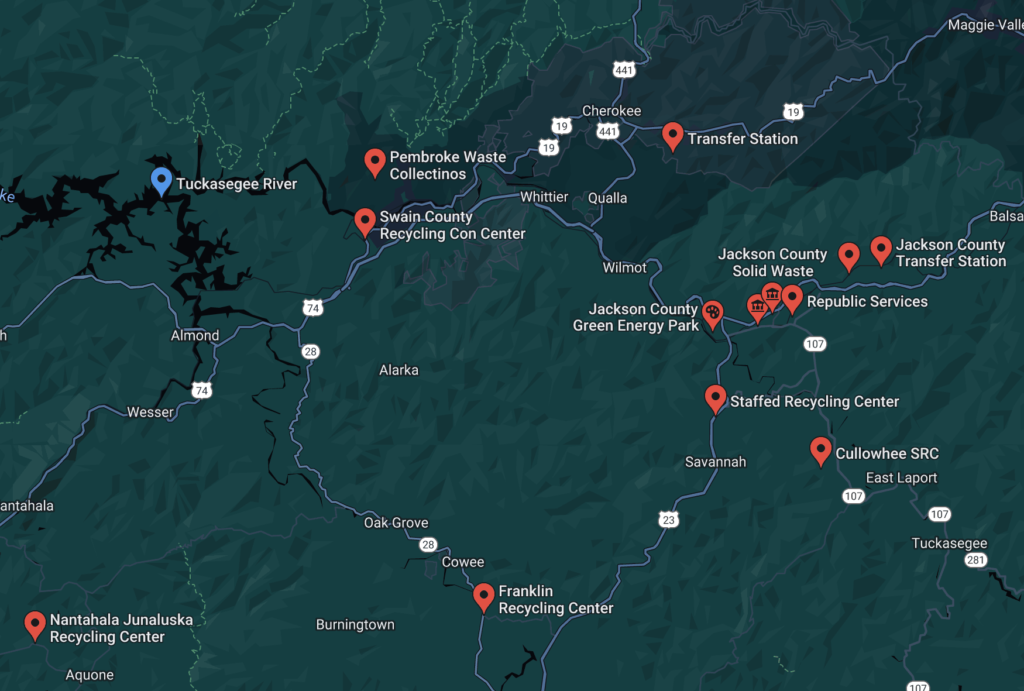In the early afternoon, with mist still clinging to the waters of the river, hundreds of WCU students descend to the banks of the Tuckasegee river for the Tuck River Cleanup.
Throughout the day, thousands of pounds of trash are removed. Digging through the muck and traversing slime covered rocks, students remove old tires, beer bottles, plastic shopping bags and much more.
With all the effort to remove trash and improve the waterways, what is inside the water may be the true threat. Removing the trash is just the beginning and may not be enough.
According to Base Camp Cullowhee,
“The Tuck River Cleanup is one of the nation’s largest single day river cleanups. Hundreds of volunteers unite to clean 20 miles of the Tuckasegee River from Cullowhee to Whittier, NC.”
Cleaning up that trash has immeasurable benefits to the natural flora and fauna of Western North Carolina. However, despite the efforts to remove trash in the water, the water quality continues to suffer.

In an article posted on ArcGIS, by Julia Cornett, Brianna Saylor, Reilly Swanson, & Kenzie Teagarden talks about how the water quality in the Tuckasegee River is listed as impaired due to a number of contributing factors.
“Water quality issues in the Tuckasegee River sub-basin include impacts from developments on steep slopes, agricultural runoff, stream bank erosion, limited riparian cover, and individual onsite wastewater failures.”
The quality of the water can also affect the aquatic life that lives in it. According to ArcGIS, “Aquatic life in the… Tuckasegee River…is currently listed as impaired because of low pH levels.”
These low pH levels can be caused by a number of sources including acid-generating rocks/soils, power plants and other sources of acidic gases, landfill leachate, confined animal feeding operations and many more. All of these potential low pH contributors have sites located in Western North Carolina.
Because of the reported low PH level, “Aquatic life harvesting status for the Tuckasegee watershed is listed as impaired for the 11-mile stretch between Town Branch and the Oconaluftee River due to high levels of mercury found in fish tissue,” said Cornett, Saylor, Swanson and Teagarden of ArcGIS.
The source of mercury in river fish could be caused by a number of things. According to the United States Geological Survey, “Some water bodies also receive mercury from direct discharge of industrial wastes, mining wastes, or naturally occurring mercury minerals.”
This is particularly damaging to Sylva and the surrounding areas because of the large fishing industry that brings in tourists yearly. A flyer released by the NC Wildlife organization quoted a study performed in 2014 on behalf of the N.C. Wildlife Resources Commission. In that study, results showed that trout anglers contributed $383 million to North Carolina’s economy.
Keith Gibbs, WCU professor of geosciences and natural resources has been studying the Tuck and says that though the water quality is considered “good,” the Tuckaseegee mirrors the same problems of other rivers throughout the U.S.
“Suspended sediments from runoff is the largest source of pollution in the Tuckasegee, however, this isn’t a unique problem. Sedimentation is the leading cause of degradation to most streams and rivers throughout the U.S.,” said Gibbs in an email exchange.
He adds that, “This can have an ecological effect because many aquatic species rely on sight to feed. If turbidity (lack of water clarity) is elevated for extended periods, then these aquatic species may not be able to find food and starve. We have several recreationally-important species like trout that help support the local tourist industry.”
N.C. Wildlife research from 2014 says that “the total cost of producing and stocking trout was approximately $1 million, providing a return on investment of $250 for every $1 spent on trout production.”
Not only does the turbidity of the water affect the feeding behavior of aquatic species, but it can also affect their reproduction.
“Many fish lay their eggs in the substrate and rely on clean gravel and cobble for egg deposition. Embedded and degraded substrate reduces the amount of reproductive habitat for fish and other aquatic organisms,” said Gibbs. “Many aquatic insects also live in substrate and are prominent food sources for a number of fish species. Freshwater mussels and salamanders, such as hellbenders, also need adequate substrate to meet their life history needs.”
Another source of pollution according to Gibbs can be in the form of animal waste and over-applied fertilizers. They can be carried in runoff leading to excess nutrients and potentially harmful algal blooms.
“Impervious surfaces, such as roofs and parking lots, can increase the volume and velocity of runoff during heavy rain events which can also carry trash and contaminants, such as oil, to our streams and rivers while also increasing the chance of erosion and sedimentation,” said Gibbs.
The WCJ did investigate further into the quality of our water with the help of Dr. Kimberlee Hall.
Dr. Hall is a WCU professor who teaches environmental health sciences, including water quality. For an independent study on water quality with two journalism students, Dr. Hall collected samples from three sources: Stillwell building at WCU (that uses the WCU water treatment plant), from the HHS Building tap water (from Tuckaseigee Water & Sewer Authority water treatment plant) and straight from the Tuckasegee River. She tested for turbidity (clarity of the water), nitrate concentration and e. coli (fecal matter).
With the e. coli results, Dr. Hall said in an email, “There was none in the drinking water samples from Stillwell and HHS, and 19.5 CFU/100ml (colony forming units) in the Tuckasegee River sample – well below the 200 CFU/100ml regulatory limit for recreational waters in North Carolina.” Dr. Hall did explain that we will see fecal matter in the water since it is from animal waste but testing helps to see how much is in the water.
The nitrate results were an average of 1.23 mg/L and the turbidity averaged with 2.02 NTU (Nephelometric Turbidity Units). These were far below the legal limit.

Though the annual Tuckasegee River Cleanup is one way to advocate for the health of the river, Gibbs says there are many other ways you can prevent degradation of the Tuckasegee. “We all have a part to play in keeping our waterways healthy.” He suggests that you should avoid any activity that removes vegetation and leaves soil exposed to the elements which can cause excess sediment to enter any adjacent bodies of water.
“Many of these beneficial actions are relatively simple and don’t require much extra effort, such as keeping our soil vegetated or at least covered to reduce erosion, avoiding over-applying fertilizers, making sure trash and recyclables are managed and contained, and maintaining our vehicles to reduce pollution from fluid leaks,” said Gibbs.
Though there are many things we can do, Gibbs suggests that one of the best things we can do is maintain a healthy riparian buffer next to streams and rivers.
“A riparian buffer is the land immediately adjacent to a waterbody. Keeping diverse and natural vegetation along our stream banks helps stabilize banks to reduce erosion and taller trees provide shade to keep water temperatures cooler in summer months. We all like a picturesque view of the mountains or a river, but allowing vegetation to grow can help save our streams for future generations to enjoy.”
Related stories: 39th annual Tuck River Cleanup highlight reel



